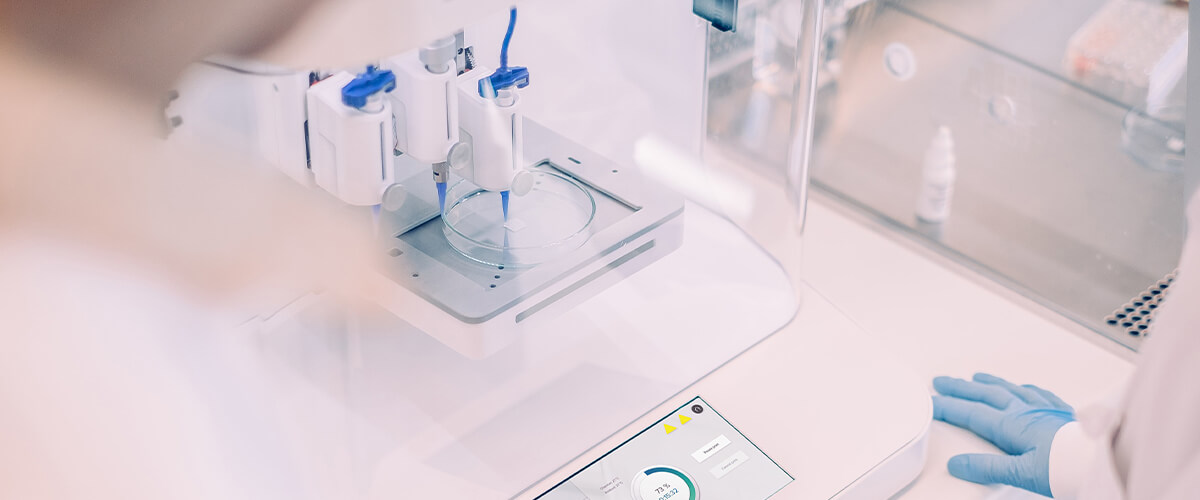A research team has developed a way of 3D printing organs without the need for scaffolding. Exciting news in the world of 3D bioprinting! The team is led by Eben Alsberg, the Richard and Loan Hill Professor of Bioengineering and Orthopaedics at the University of Illinois at Chicago.
TL;DR
The new technique prints the organ directly into a microgel.....
When this gel is exposed to UV light it "freezes" in place. The 3D printed cells can then grow in an incubator. When the bioprint has matured the bonds of the microgel can be removed by simply shaking. The bioink is made from stem cells.
The problem
Most current bioprinting technologies rely on scaffolding to hold their bioprint in place while it matures and this can cause many issues. Typically, the scaffolding must be engineered to degrade, however, timing this can be problematic, as can the unwanted by-products produced when said material degrades. In addition, the scaffolding can get in the way of cell growth. This new technique is an important development because it sidesteps these issues.
The solution
The new technique involves printing the organ directly into a "microgel". This microgel is strong enough to support the 'bio-ink" but flexible enough to allow the needle, used as a printing head, to pass through. Moreover, the solution is self-healing, which means that the microgel will not become deformed during the printing process.
The microgel is a solution of, suspended, crosslinked, nano-beads, created by suspending nano, hydrogel beads in a liquid.

Still taken from the published article. Use for illustrative purposes that could not otherwise be conveyed. All right retained by original author.
Collectively, this system, which is applicable to general 3D printing strategies, is a paradigm shift for printing of scaffold-free individual cells, cellular condensations and organoids, and may have far reaching impact in the fields of regenerative medicine, drug screening, and developmental biology.
The printing
The "bio-ink" used was made from stem cells. This was loaded into a needle and then feed into the microgel. You can watch the printer in action.

Examples of 3D bioprinted structures using this technique (a)a hand (b)a letter "C" (c) before and (d) after photocrosslinking the acronym "UIC. Scale bars indicate 5 mm. Use for illustrative purposes that could not otherwise be conveyed. All right retained by the original author.
Incubation
The microgel is "frozen" in place with UV light. This is known as "photocrosslinking" and provides the suspended stemcells and solid structure on which to grow. It works in a similar way to the technique developed by the University of Michigan. The University of Michigan's technique prints 3D objects from liquid, but in reverse. With the new bioprinting technique, it is the supporting structure that becomes solid when exposed to the light and not the print material itself.
The advantage of the frozen-in-place microgel support is that, unlike traditional support structures, it can be used to provide the growing cells with nutrients and remove waste products. Once the frame is set in place they added a "culture media" to the print and placed it in an incubator at body temperature.
When the cell structure has finished maturing the microgel bonds can be removed by simply shaking the structure.
3D printers printing printers to print humans
Whilst that does sound like something out of science fiction, 2 of the printers used were converted from 2 commercially available 3D printers. They were adapted with a custom printing head was printed by one of these machines!
A specific bioprinter was also used with biospecific software for some of the test pieces.
Download your own files
Many of the files used are open source and freely available. Now you too can 3D print your own organs:
- Printhead -- NIH 3D Print exchange
- Human femur -- NIH 3D Print exchange
- Human ear -- Thingiverse
- 3D printing Software -- Ultimaker Cura software (free)

3D ear model opened in BricsCAD using the Communicator for BricsCAD.
Fancy making your own 3D-printable models?
It's easy with BricsCAD Shape. Download free for life at www.bricsys.com. Then make the effortless move to BricsCAD. Freedom of choice, plus perpetual (permanent) product licenses that work with all languages, in all places. You'll love what we've built for you with the BricsCAD® product family.
Disclaimer: All brand names and product names mentioned in this post are trademarks or service marks of their respective companies.
These links are being provided as a convenience and for informational purposes only; they do not constitute an endorsement or an approval by Bricsys of any of the products, services or opinions of the corporation or organization or individual. Bricsys bears no responsibility for the accuracy, legality or content of the external site or for that of subsequent links. Contact the external site for answers to questions regarding its content.

